For those that have taken the thought leadership course focused on our emerging future, thank you. For those that may have interest, the course will run for foreseeable future. In this post from last year, I summarized the key messages from the course. It has been updated to reflect the progression of our emerging future.
Yogi Berra is credited for once saying that the future ain’t what it used to be. What a perfect way to describe what is coming: a complete change in the way we think about the future. Our journey to the future begins with a look back. A convergence of multiple forces during a special century following the U.S. Civil War established the standard of living in developed economies. Some believe that we will never see a convergence of forces as dramatic and impactful as that which occurred during this period. I pulled this wheel together to capture that convergence across the various areas of our well-being, leveraging the work of economist Robert J. Gordon. I captured his thinking in a recent post titled Revolution and the Innovation Wheel.
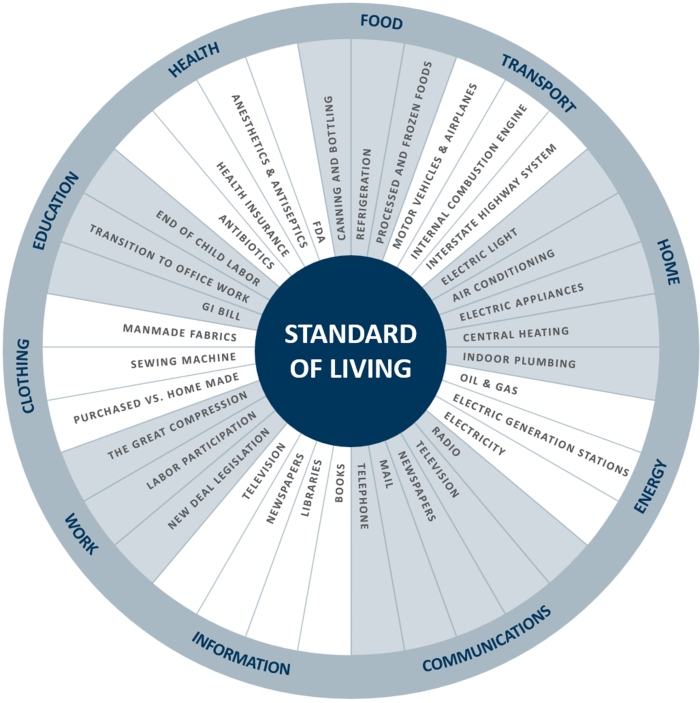
Fast forward to 2018. We are seeing exponential convergence across the areas of science, technology, economics, society, ethics, environment, and politics. The combinatorial nature of an overwhelming number of building blocks drives an accelerating intersection across these areas. It is this combinatorial and exponential dynamic that I believe ushers in human histories third major tipping point (the first two being hunter-gatherer to agriculture and agriculture to industrial).

I have been using an anchor visual to describe this emerging future. I’ll build towards that visual to describe the components. The first two areas that are converging, exploding and fueling each other are science and technology. We have entered the second half of the chess board, where an endless supply of building blocks fuels combinatorial innovation. The second half of the chessboard is a phrase coined by Ray Kurzweil an American author, inventor, futurist, and director of engineering at Google. As Kurzweil explains, once you reach the second half of the chessboard, changes are exponential. Each new square doubling that of the previous. Moore’s Law is said to have entered the second half of the chess board in 2013. A good description can be found here.
A curve was chosen as the anchor for the visual to express the notion that innovation is emerging so rapidly that it changes the nature of horizon planning. The emergent nature of value through the rapid combination of building blocks adds a speed and uncertainty dimension that makes it difficult to see (the curve goes off into distant places). Seeing, therefore, becomes a critical component of any future thinking framework. The foundation of this convergence is digital. The primary digital components are still viewed in isolation as opposed to the third IT platform, but they will converge to form this platform.
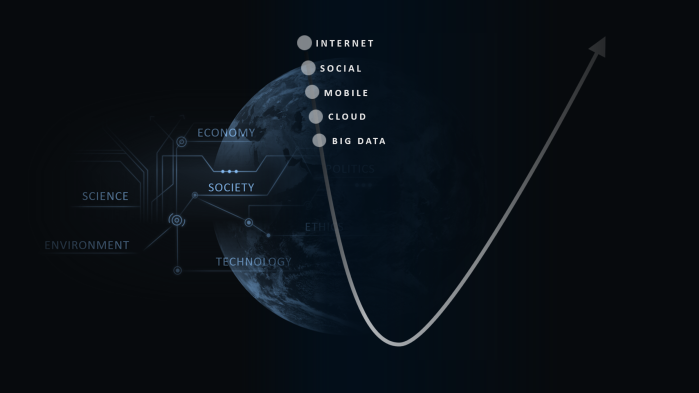
Converging onto the foundation are many emerging innovation accelerators. These accelerators and the ones that follow, take our IT platform to a general-purpose technology platform (GPTP). This phenomenon is described in greater detail here. A GPTP has historically been the driver of past revolutions.
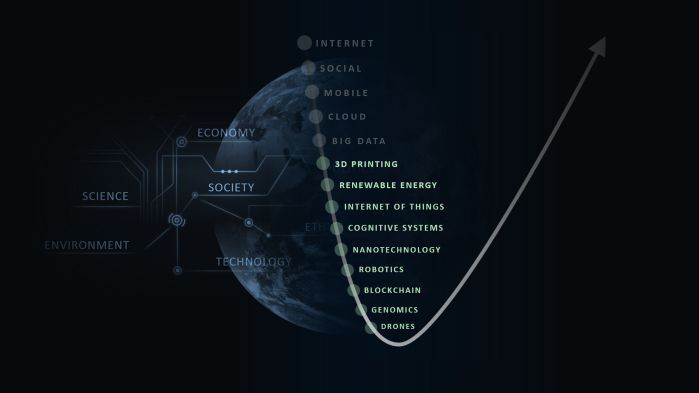
Several future accelerators are likely to appear on the horizon, some in the near term and others off into the future. As mentioned, it is impossible to predict when or if these innovations reach tipping points. It is safe to assume however that the speed at which they progress will increase.
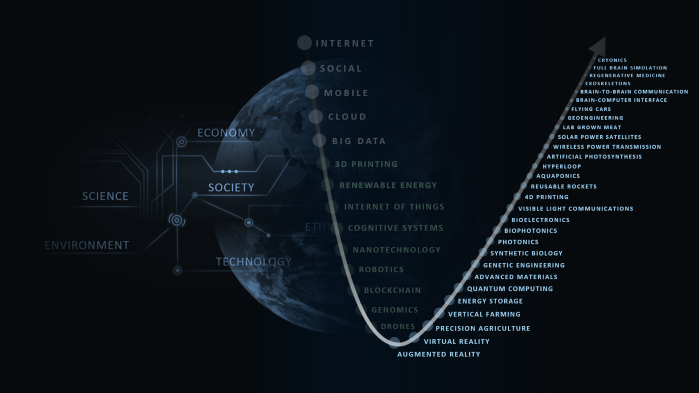
As science and technology converge, they are enabling many future scenarios. The path of these scenarios is influenced by social, political and economic forces – and a growing ethical conversation. One of the biggest leadership challenges of this century is understanding and managing the implications of these scenarios and others on humanity.
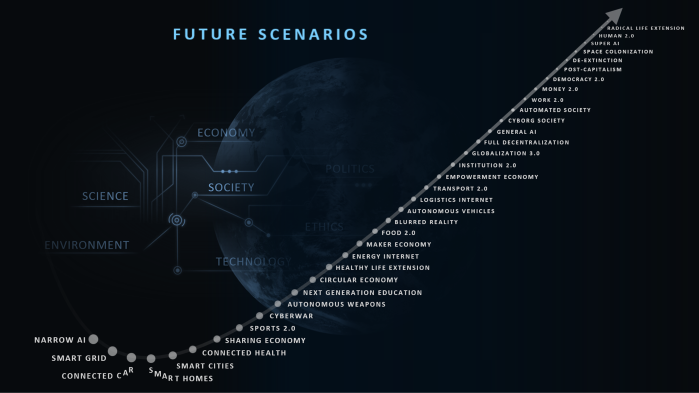
Update July 11, 2018: new future scenarios were added: Globalization 3.0, Post-Capitalism, and Autonomous Weapons.
These two curves – extending beyond our ability to see – are driving societal change, and reacting to societal forces. For example, scientific and technological innovation are increasingly driven by techno-philanthropists that are determined to solve some of the world’s greatest challenges. Look at the mission statement of Singularity University: Our mission is to educate, inspire, and empower leaders to apply exponential technologies to address humanity’s grand challenges. In this case, the progression on our curves is driven by the wealth and societal focus of individuals. On the other hand, the curves are changing society, as societal shifts like the move from ownership to access are driven my innovation across the curves.

Update July 11, 2018: a number of societal factors were added.
Collectively, this convergence of science, technology, and societal forces builds the path to our future. When you pull it all together, you get the anchor visual that I have used to tell this story. The first curve spawns the second, influencing the path of society, while at the same time, influenced by it.
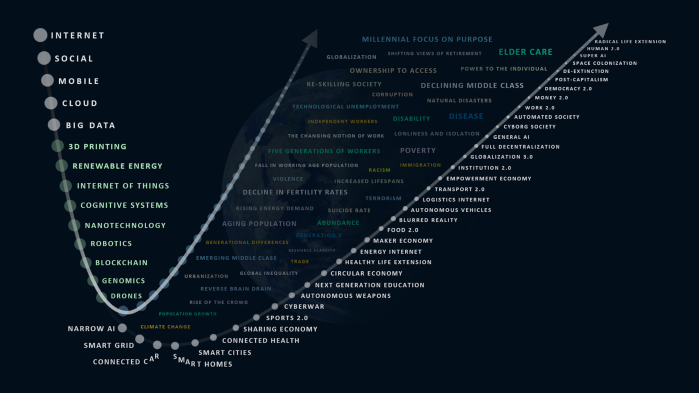
Convergence is not confined to the individual curves. As future scenarios accelerate and mature, convergence increasingly occurs across the curves. These forces will combine and intersect in ways that accelerate and amplify their impact. This visual portrays the complexity of not just seeing the dots, but connecting them in ways that help us understand the new scenarios that may emerge, and the implications of those connections. This healthy life extension example identifies several building blocks that come together to enable longer, healthier lives.
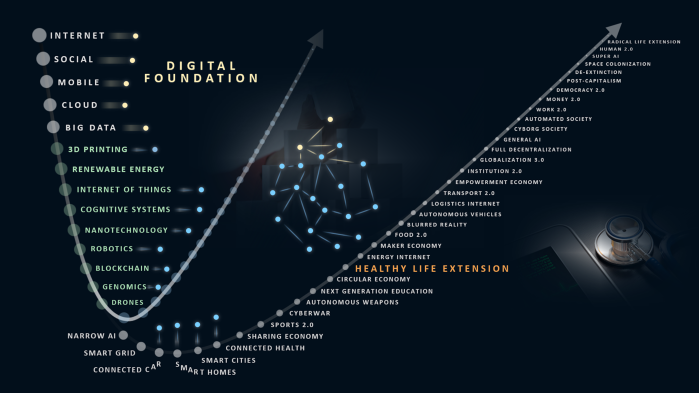
Update July 11, 2018: replaced generic visual with a future scenario example.
The ultimate question is this: will the convergence in this century replicate or surpass the societal impact that convergence enabled in the special century? I developed this expanded innovation wheel to map the elements of our curves to the various areas of our well-being. Overlaying those components on top of the original wheel. Not only do I believe we have the potential to improve our standard of living, but I believe we can enable global parity. The opposite is also true. These same innovations have the potential to diminish our humanity, requiring us to Balance the Opposing Forces of Innovation.

Update July 11, 2018: the innovation wheel was updated to reflect new innovations
The final piece of our emerging future story is the likely Collapse of Traditional Structures. As we journey forward, the institutions and structures that were built for a different era will collapse. Our purpose orientation will pave the way to new structures, as horizontal ecosystems replace our vertical constructs. As platform business models are embraced for their growth potential, ecosystems will form around those platforms. The resulting fragmentation ultimately leads to consolidation. It is my belief that this consolidation leads to a finite set of ecosystems that replace our current industry constructs.

Discover more from Reimagining the Future
Subscribe to get the latest posts sent to your email.

Hmm. Interesting read. I wonder though who will translate this to ordinary language. Someone once said “the thing about the future is that once you know it, it changes”. The knowledge and capacity divide between the developed and developing worlds remains significant emphasizing the downside risks towards ‘diminishing our humanity’.
LikeLike
A whole lotta jibber jabber
to faux-intellectually say/rationalize
“the future is totalitarian.”
NO THANKS.
LikeLiked by 1 person
Would never be for that – just looking for the innovation that is coming to solve some of our biggest challenges
LikeLike
Hi Frank,
Thought provoking and interesting as always. I expect that we will need some pro-active regulatory and legislative intervention to dampen the effect of winner takes all business models destroying more economic value than they amass. Failing that, the probability is that digital disruption will lead to social disruption, and we know what that usually entails…
T.
LikeLiked by 1 person
Completely agree. It will be a difficult balance between enabling innovation that enhances society and mitigating the risk of unintended consequences
LikeLike
[…] Nós estamos no auge de outro grande avanço no padrão de vida, não só nos países desenvolvidos, mas também em áreas desatendidas com o potencial de atingir paridade global. Considere o impacto da água limpa em áreas rurais e como isso propiciou ambientes e vidas mais saudáveis em países em desenvolvimento. Os avanços tecnológicos em robótica, nanotecnologias, inteligência artificial e biotecnologia estão tornando isso possível e todos seremos mais saudáveis e felizes por causa deles. Para mais detalhes, recomendo um post do meu blog, “The Future Ain’t What it Used to Be”. […]
LikeLike
[…] The future clearly isn’t what it used to be. While running for president in 1932 during the depths of the Great Depression, Franklin Roosevelt remarked, “The country needs and, unless I mistake its temper, the country demands, bold, persistent experimentation.” Globally, I’d say we are in that same place; an emerging era of experimentation driven by the fact that there are no clear answers to the challenges looming before us. Some of these challenges are described in this piece on The global forces inspiring a new narrative of progress. […]
LikeLike
[…] the emerging future visual is but a small attempt to focus on possible futures. So to the visual (Explained Here) we add Republic […]
LikeLike
[…] The sheer number of building blocks makes this era different than the ones that have come before it – and it’s not just the number, but the way the building blocks are Intersecting. For example, figure 1 depicts a number of building blocks that are converging to transform mobility. Building blocks can be innovations in science and technology, societal change, and emerging future scenarios among others . Followers of my Blog are familiar with this anchor visual. I use it as a canvas to describe various aspects of our emerging future (anyone new to the Blog can find a description Here). […]
LikeLike
[…] book touches upon several elements of both curves; and the societal factors affecting them both (Explained Here). As a way of sharing some of the book’s messages, I’ve taken short extracts and aligned them […]
LikeLike
[…] visual below depicts aspects of our emerging future (Explained Here). I update it periodically to reflect impactful areas that affect the science and technology […]
LikeLike
[…] for action. The best of global human development should be in front of us – not confined to a Special Century from our […]
LikeLike
[…] continues. The focus, investment and rapid advancement in this space has changed the way leaders Think about the Future. The science-fiction feel of a future-focused discussion has disappeared – replaced by the […]
LikeLike
[…] impact in either direction – but we could add several other stations based on the number of Building Blocks available to society. Click on the visual to expand […]
LikeLike
[…] phenomenon in a visual titled Our Emerging Future. A full description of the visual can be found Here. After reviewing the 2019 Trends Report from the Future Today Institute, I added a significant […]
LikeLike
[…] Story telling is the most effective way to communicate – and in times of complexity, uncertainty, and rapid pace, it becomes even more critical. Telling stories about the future requires a broad view of an increasing number of building blocks. The visual I use attempts to look at these building blocks and the various ways they combine to enable future scenarios. The scenarios themselves are combinatorial – converging on one and other in ways that transform how we think about the future. A deeper explanation of the visual can be found Here. […]
LikeLike
[…] Origen: El futuro no es lo que solía ser | Reimaginar el futuro […]
LikeLike
[…] impact in either direction – but we could add several other stations based on the number of Building Blocks available to […]
LikeLike
[…] convergence across the areas of science, technology, economics, society, ethics, and politics. The combinatorial nature of an overwhelming number of building blocks drives an accelerating intersection across these […]
LikeLike
[…] exponentiell konvergens inom områdena vetenskap, teknik, ekonomi, samhälle, etik och politik. De kombinatorisk natur av ett överväldigande antal byggstenar driver en accelererande korsning över dessa områden. Som […]
LikeLike
[…] impact in either direction – but we could add several other stations based on the number of Building Blocks available to society. Click on the visual to expand […]
LikeLike
[…] Berra is credited with saying that the future ain’t what it used to be. What a perfect way to describe a phase transition that completely changes the way we think about […]
LikeLike
[…] domains in either direction – but we could add several other stations based on the number of Building Blocks available to society. Click on the visual to expand […]
LikeLike